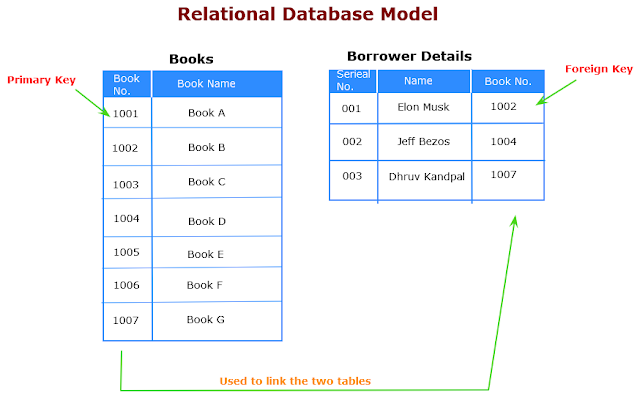There are primarily 5 types of Databases:
- Hierarchical Database
- Network Database
- Object-Oriented Database
- Relational Database
- No-SQL Database
Let's understand them one-by-one!
1. Hierarchical Database
In a hierarchical database, data is categorized by ranks or levels. This categorization is based on some common point of linkage. Hence, a data set can give rise to two or more sub data sets, all having some common links with the parent data set.
This type of database can also be visualized as a parent child relation where a parent set gives rise to multiple child sets, thus resembling a 'tree'.
One of its major disadvantages is that it allows a child to have only one parent.
2. Network Database
One of the major disadvantages of Hierarchical Database was that it didn't allow a child to have multiple parents. This means that, having a sub data set resembling two parent data sets was not possible there.
This problem was solved by Network Database. It allows a child data set to have multiple parents data sets associated with it. This gives it an edge over Hierarchical Database.
One of its major disadvantages is its complexity which makes it difficult to understand as well as alter.
3. Object-Oriented Database
An Object-Oriented Database sees a particular data set as an object which can be called whenever needed. This is similar to the approach which programming languages like Python/Java use.
This separation of data in form of callable objects makes this type of database much more efficient, easy-to-use and alterable than other databases discussed before.
4. Relational Database
Relational Database is one of the most widely used database around the world. In it, each and every piece of information is linked with each and every other piece of information.
Data is a relational database is stored in the form of tables. Every row of data is linked in a table using a primary key which is unique for every record.
Similarly, rows in different tables can be interlinked using a foreign key.
Using tables as a method to store data has made this database incredibly popular. It makes data easy to organize, view and alter.
Another advantage associated with it is the use of a simple language to insert, view or alter the data. Here, we are talking about SQL (Structured Query Language).
Popular SQL based databases are: MySQL, Oracle, etc.
5. No-SQL Database
No-SQL databases also known as Non-Relational Databases provides means to store and manage data other than tables.
These databases help to increase the simplicity as well as the scalability of data. When used for specific purposes, these type of databases can provide much better efficiency in data management than relational databases.
Nowadays, using No-SQL databases is becoming increasingly popular among DevOps for its simplicity and scalability.
Popular No-SQL databases are: MongoDB, Cassandra, etc.
These were some of the databases commonly used around the globe. Normally, companies don't use one type of database alone but a hybrid database which is made for their specific use-case.
~~~~~~~~~~~~~~~~~~~~
Previous: What is a Database?
This article is a part of our MySQL Tutorial for Beginners Series.






















No comments:
Post a Comment